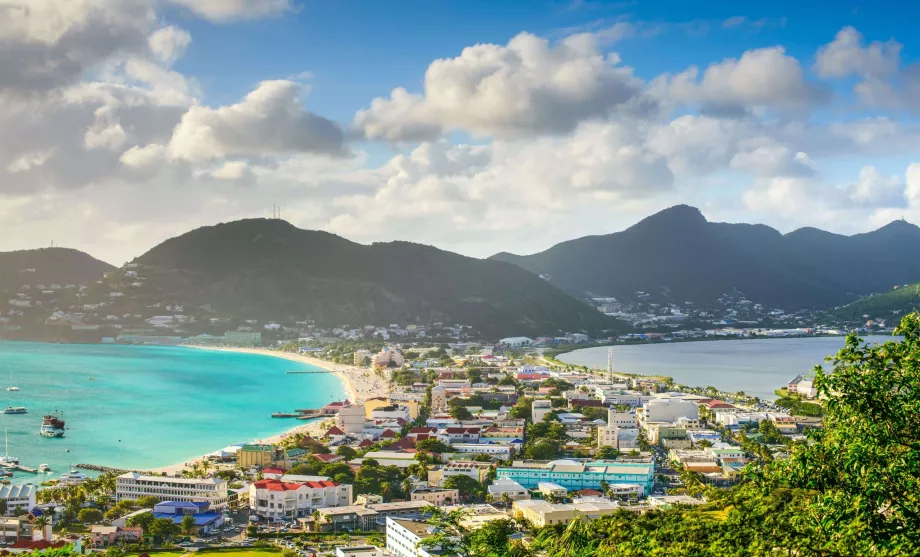Weather in Sint Maarten and best time to go

St. Martin's Island is situated in a tropical monsoon climate, which is characterized by long periods of dry and fine weather and shorter periods of wet and hurricane weather.
Due to the location of the mountains in the middle of the island and the shape of the coastline, St. Martin is slightly drier than the surrounding islands of the Lesser Antilles.
However, even during the dry months, you have to expect rainy days, but they are less likely than during the rainy season.
Temperatures are summer all year round and the differences between winter and summer are minimal. The variance of average daily temperatures throughout the year is between 28 °C and 31 °C. Extreme heat with temperatures over 35 °C only occurs in summer, and there are only a few cooler days below 22 °C a year.
Book a hotel with an off-season discount
Weather and temperatures during the year
This is how the weather in St Martin looks like during the different months of the year.
Weather in January
During January, the high season begins with pleasant temperatures of around 25 °C and relatively low humidity.
Rain occurs on average 11 days a month, but most of the time it is just short showers that blow over in a few dozen minutes. However, there may be 3-day periods of constant rain.
January is often quite a windy month, but this combined with the high temperatures doesn't matter.
Weather in February
February is a great month to visit St Martin. The weather is mostly sunny and although on average it rains 9 days a month, it rarely rains all day.
Temperatures are around 25°C and there is often windy weather and low humidity, which together make being outdoors very pleasant.
Weather in March
March is statistically the least rainy month of the year. Precipitation falls mainly in the form of intense but very brief showers and only occurs 8 days out of the month.
Average temperatures of around 25 °C are cooled by the wind, which blows constantly, especially along the coast.
Weather in April
During April, the average temperature rises to 26-27 °C and rainfall increases slightly.
However, April is still in the dry season and it rarely rains all day long. The humidity remains at a reasonable level, so that even during April, as well as swimming in the sea, you can explore the island on foot.
Weather in May
May is also a good month to visit St Martin. Although rainfall increases and heavy thunderstorms with torrential rain are relatively frequent, this usually happens in the evening or at night and during the day it is sunny or partly cloudy.
During the day, expect temperatures around 27 °C and a slight breeze.
Weather in June
June can be described as the last month of the dry season, with showers mostly in the form of short, intense precipitation.
However, the sun is more often obscured by clouds than in winter, which can have positive connotations for travellers who are not comfortable with constant exposure to direct sunlight.
The average daily temperature rises to 28 °C, but can often rise above 30 °C.
Weather in July
July sees the dry season turn into the wetter rainy season, but the main hurricane season is still not yet upon us.
Temperatures are very high and can often reach 32 °C. However, humidity and rainfall remain at tolerable levels and it almost certainly won't rain every day.
Despite July being high season for most of the world, prices for accommodation and services on St Martin are slowly falling as it is already low season.
Weather in August
During August, the rainy season and hurricane season sets in.
However, if you can find very cheap flights or accommodation, you don't have to worry about travelling to St Martin. The likelihood of a hurricane in July is about once every 3 years. Violent tropical storms often occur, but usually during the night hours.
The air temperature normally rises to 30°C.
Weather in September
September has the highest risk of hurricanes, but even in this month a devastating hurricane does not occur every year, but rather once a decade.
Nevertheless, it rains frequently in September: on average 14 days a month, and the rainfall is often quite heavy.
Daytime temperatures rise to an average of 30 °C and humidity increases considerably.
The weather in October
October also counts as hurricane season and a rather rainy season. It rains frequently and intensely, but rarely lasts all day.
Intense rain is often replaced by clear skies inviting to swim in the sea. Accommodation prices in October are the lowest of the year.
Outside, the humidity is high and temperatures around 30 °C.
Weather in November
The rainy season on St Martin is slightly delayed compared to the more southerly islands, so the whole of November is also in the rainy season.
According to statistics, it is in November that it rains the most days (up to 15 per month). Even during November, however, it rarely rains all day and showers are replaced by sunny skies.
The daytime temperature rises to 28 °C.
Weather in December
During December, the wet season breaks and the high season begins. Precipitation significantly decreases compared to autumn and from mid-December onwards the weather is mostly partly cloudy or completely clear.
Temperatures drop to a more comfortable 27 °C and humidity also decreases.
Sea temperature
The water in the Caribbean Sea off the coast of St Martin is similarly warm throughout the year.
The temperature oscillates between 27 °C and 30 °C. The sea temperature is lowest in winter (December to February) and highest in late summer (August to October).
Table of temperatures during the year
Saint Martin - Weather does not differ regionally
When to go to Sint Maarten
The main tourist season is from mid-December to mid-May. During this period, everything is much more expensive and there are many more tourists on the island than outside of it, but again, you are virtually guaranteed that the weather will work out.
You're in the tropics, so even in the dry season it can and probably will rain, but mostly it's just short storms in the early evening or at night.
Compare prices for flights to St Martin
However, if you'd like to save on accommodation, car hire, tours, flights and pretty much everything except food, which still costs the same, and if you'd like to have the beaches to yourself and not squeeze in a million people on Maho Beach either, then it's best to take a chance on an off-season trip.
During hurricane season, we always recommend renting a car so that you can at least explore the island hidden under a roof in case of rain.
What are the best months to visit?
Consistent weather, with the least rainfall and most pleasant temperatures between 26 and 28°C, prevails from December to April. During this period it showers on average once a day, usually in the evening or at night. The rain can be very heavy and start without warning.
However, it usually lasts between 2 and 10 minutes.
In addition, it rarely rains all over the island, but only in narrow, circumscribed bands.
When is the rainy season on St. Martin?
The heaviest rains come in early August and the wet season ends in late November and early December. During these months it can rain up to several times a day, but usually these are still only short heavy thunderstorms lasting up to 30 minutes.
All-day cloudy skies are definitely more frequent than in winter, but even so they are relatively few: on average 5-7 times a month.
Are there hurricanes on St. Martin?
Yes, the island is in a hurricane zone.
The hurricane season runs from August to November, with the most hurricanes statistically occurring in September and October. On average, a hurricane hits St. Martin once a year and is very difficult to predict for more than a week in advance.
There are years when no hurricane hits the islands, on the other hand there are years when there are 3 hurricanes.
However, a devastating hurricane that completely cripples life on an island for a few days only occurs about once every 8-10 years.
In addition to hurricanes, there are also strong tropical storms during this period, which may not cause as much damage, but can affect the holiday for up to 5 days at a time.
Any questions left?
If you have any questions or comments about the article...

